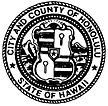
City Council
revisits rail transitState and city officials hope
to come up with an agreeable
plan to examine feasibility
The City Council may move ahead with rail transit, an issue it derailed more than 10 years ago.
"I'm hoping to get the Council to show preference for a light rail or a fixed rail, probably an elevated fixed-rail system, because I think that would move toward a consensus between the city and the state," Council Chairman Gary Okino said.
Okino has drafted a resolution that calls on the city administration to come up with a plan to put a fixed-rail system into effect. Rail systems can vary from light projects with rails or trolley lines to heavy ones with concrete structures dedicated to transit cars.
Okino, a member of a task force convened by Gov. Linda Lingle to explore solutions to traffic gridlock on Oahu, said the resolution would put the state and city closer to agreement on one plan.
"The state administration (seems) very receptive to a fixed-rail system," Okino said. "I think it's moving decidedly in the direction of a fixed-rail system. The only thing missing is the Council taking a position on it."
"Maybe (we can) recommend how we're going to pay for this, finance the system, what needs to be done. So in that way, Council members can support a fixed-rail system without locking us into this thing until we look at some of the feasibility issues," Okino said.
Okino said a hearing could be held in October and the Council could take a vote at its November meeting.
In 1992, a fixed-rail plan was killed after the City Council voted 5-4 against a tax increase to pay for the city's share of the cost. As a result, millions of dollars in federal funding were lost.
State and city officials -- the governor, mayor, Legislature and City Council -- are hoping to come up with one plan they can agree on to avoid that kind of roadblock again.
Mayor Jeremy Harris, also a member of the task force, said he doesn't think the group has decided on a route yet. "My reading is that the task force and the governor haven't zeroed in on any particular transportation solution."
Harris said his recommendation -- if the group does agree on a fixed-rail system -- is that such a project would not go through the federal funding process initially.
"If there's one thing we've learned in the last 35 years is the process to be eligible for federal funds is so long and expensive and it adds so much to the cost of the project, you're better off just deciding that you'd like to pay for it locally," Harris said.
Instead, the mayor said, a source of local funding -- like an excise or sales tax -- should be dedicated to the project.
Harris said he couldn't comment specifically on the resolution until he sees it. He said if the Council votes in favor of the measure, it doesn't necessarily mean the end of the regional portion of his controversial Bus Rapid Transit plan.
"Regional BRT is one basically cheap, quick alternative that could be put in place while a rail system is being funded and designed," Harris said.
Okino said the in-town BRT or an enhanced bus system could also act as a feeder system from the fixed-rail system, but without the exclusive lanes.
But Budget Chairwoman Ann Kobayashi said she won't vote for any further funding for BRT.
"I think whatever transportation system is done for part of the island, we should look at a continuation to Waikiki or something compatible," Kobayashi said. "Whatever the task force suggests, we will certainly take a good look at it."
